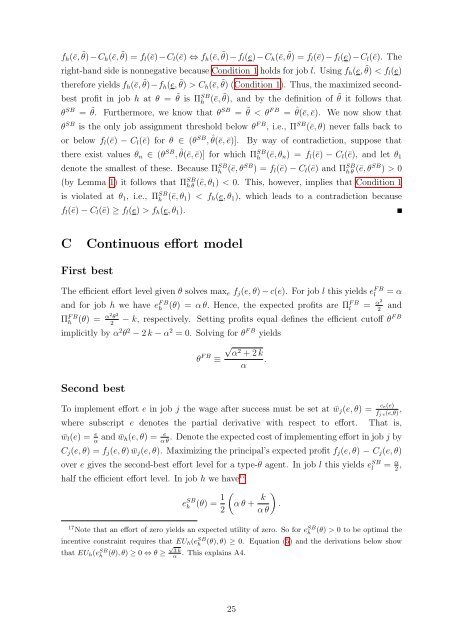Job Assignments under Moral Hazard - School of Economics and ...
Job Assignments under Moral Hazard - School of Economics and ...
Job Assignments under Moral Hazard - School of Economics and ...
Create successful ePaper yourself
Turn your PDF publications into a flip-book with our unique Google optimized e-Paper software.
fh(ē, ˜ θ)−Ch(ē, ˜ θ) = fl(ē)−Cl(ē) ⇔ fh(ē, ˜ θ)−fl(e)−Ch(ē, ˜ θ) = fl(ē)−fl(e)−Cl(ē). The<br />
right-h<strong>and</strong> side is nonnegative because Condition 1 holds for job l. Using fh(e, ˜ θ) < fl(e)<br />
therefore yields fh(ē, ˜ θ)−fh(e, ˜ θ) > Ch(ē, ˜ θ) (Condition 1). Thus, the maximized second-<br />
best pr<strong>of</strong>it in job h at θ = ˜ θ is Π SB<br />
h (ē, ˜ θ), <strong>and</strong> by the definition <strong>of</strong> ˜ θ it follows that<br />
θ SB = ˜ θ. Furthermore, we know that θ SB = ˜ θ < θ F B = ˆ θ(ē, ē). We now show that<br />
θ SB is the only job assignment threshold below θ F B , i.e., Π SB (ē, θ) never falls back to<br />
or below fl(ē) − Cl(ē) for θ ∈ (θ SB , ˆ θ(ē, ē)]. By way <strong>of</strong> contradiction, suppose that<br />
there exist values θn ∈ (θSB , ˆ θ(ē, ē)] for which ΠSB h (ē, θn) = fl(ē) − Cl(ē), <strong>and</strong> let θ1<br />
denote the smallest <strong>of</strong> these. Because ΠSB h (ē, θSB ) = fl(ē) − Cl(ē) <strong>and</strong> ΠSB h θ (ē, θSB ) > 0<br />
(by Lemma 1) it follows that ΠSB h θ (ē, θ1) < 0. This, however, implies that Condition 1<br />
is violated at θ1, i.e., ΠSB h (ē, θ1) < fh(e, θ1), which leads to a contradiction because<br />
fl(ē) − Cl(ē) ≥ fl(e) > fh(e, θ1).<br />
C Continuous effort model<br />
First best<br />
F B<br />
The efficient effort level given θ solves maxe fj(e, θ) − c(e). For job l this yields e<br />
l<br />
= α<br />
F B<br />
B<br />
<strong>and</strong> for job h we have eh (θ) = α θ. Hence, the expected pr<strong>of</strong>its are ΠFl α2 = 2 <strong>and</strong><br />
F B Πh (θ) = α2θ2 2<br />
B<br />
− k, respectively. Setting pr<strong>of</strong>its equal defines the efficient cut<strong>of</strong>f θF<br />
implicitly by α2θ2 − 2 k − α2 = 0. Solving for θF B yields<br />
θ F B √<br />
α2 + 2 k<br />
≡ .<br />
α<br />
Second best<br />
To implement effort e in job j the wage after success must be set at ¯wj(e, θ) = ce(e)<br />
fj e(e,θ) ,<br />
where subscript e denotes the partial derivative with respect to effort. That is,<br />
¯wl(e) = e<br />
α <strong>and</strong> ¯wh(e, θ) = e . Denote the expected cost <strong>of</strong> implementing effort in job j by<br />
α θ<br />
Cj(e, θ) = fj(e, θ) ¯wj(e, θ). Maximizing the principal’s expected pr<strong>of</strong>it fj(e, θ) − Cj(e, θ)<br />
over e gives the second-best effort level for a type-θ agent. In job l this yields e SB<br />
l<br />
half the efficient effort level. In job h we have 17<br />
e SB<br />
h (θ) = 1<br />
<br />
α θ +<br />
2<br />
k<br />
<br />
.<br />
α θ<br />
α = 2 ,<br />
17 SB<br />
Note that an effort <strong>of</strong> zero yields an expected utility <strong>of</strong> zero. So for eh (θ) > 0 to be optimal the<br />
incentive constraint requires that EUh(eSB h (θ), θ) ≥ 0. Equation (5) <strong>and</strong> the derivations below show<br />
that EUh(eSB h (θ), θ) ≥ 0 ⇔ θ ≥ √ 3 k<br />
α . This explains A4.<br />
25
















